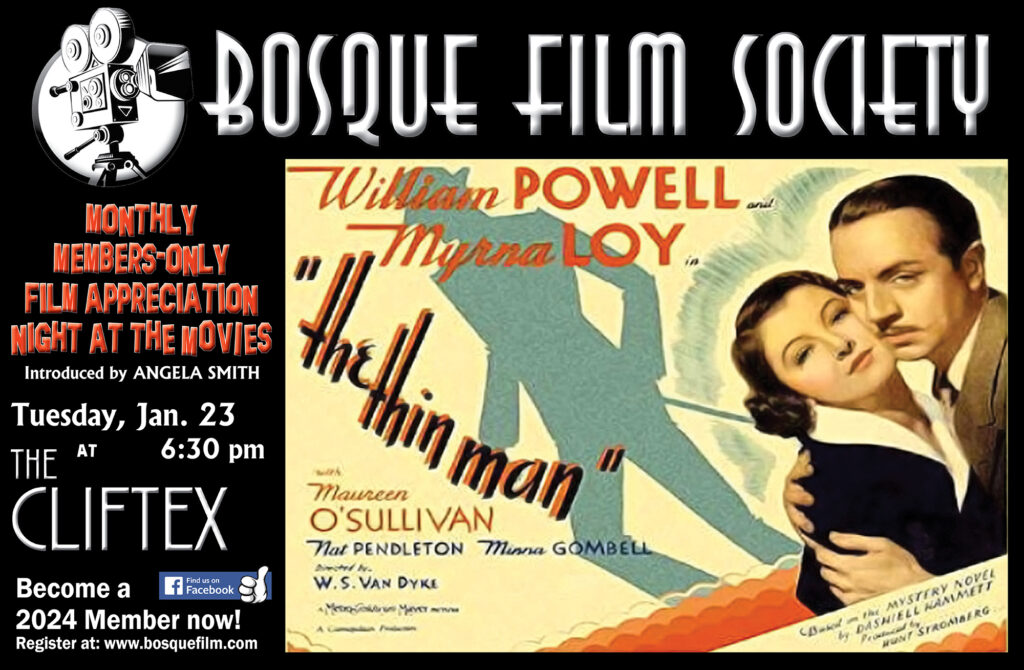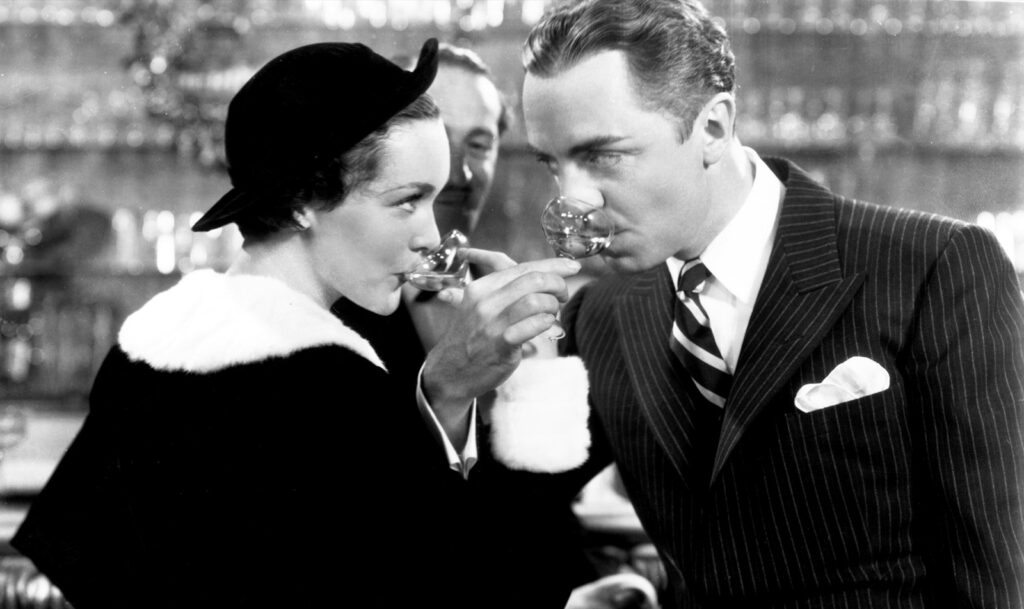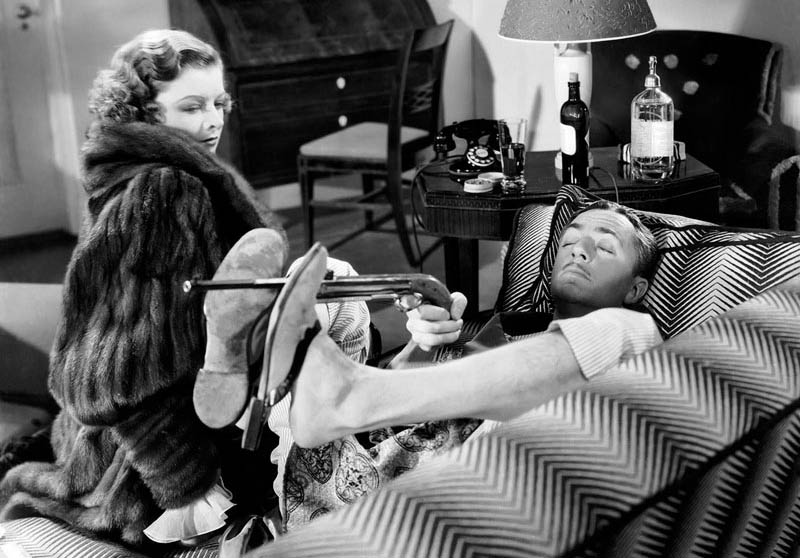In a setting fitting of the film, 2024 Film Appreciation Night At The Movies Series opens with class and style featuring 1934 comedy-mystery “THE THIN MAN” at the historic Cliftex Theatre in Clifton
By ANGELA SMITH
Bosque Film Society Founding Board Vice President
“Ladies and gentlemen, we come here tonight with a mystery to solve, but, more importantly, empty glasses to fill.”
With the setting of The Cliftex Theatre, restored to its 1930s era ambiance, the perfect stage was set for the opening of the Bosque Film Society’s 2024 Film Appreciation Night At The Movies Series by all moviegoers with some delightful entertainment with MGM’s classic 1934 box-office hit “THE THIN MAN.”
 Several days ago, I mentioned to fellow board member Nathan Diebenow that I had selected this feature to present. Nathan asked, “That’s film noir, isn’t it?” And I replied, “No, it’s a comedy.” Well, actually, it’s both. I never really think of it in the same light as say “The Maltese Falcon,” a later film also adapted from a novel by Dashiell Hammett, considered one of the fathers of American Film Noir. The Thin Man is a comedy… with cocktails… and corpses.
Several days ago, I mentioned to fellow board member Nathan Diebenow that I had selected this feature to present. Nathan asked, “That’s film noir, isn’t it?” And I replied, “No, it’s a comedy.” Well, actually, it’s both. I never really think of it in the same light as say “The Maltese Falcon,” a later film also adapted from a novel by Dashiell Hammett, considered one of the fathers of American Film Noir. The Thin Man is a comedy… with cocktails… and corpses.
The pre-Code comedy-mystery’s screenplay was written by the husband and wife team Albert Hackett and Frances Goodrich, and the film was directed by W. S. Van Dyke, who also had an influence on the screenplay development. Mordaunt Hall of The New York Times called it “an excellent combination of comedy and excitement”, and the film appeared on the Times year-end list of the 10 best of the year.
“The Thin Man” was nominated for four 1935 Academy Awards (best picture, best actor, best director, and best screenplay); and, in 1997, the film was added to the United States National Film Registry having been deemed “culturally, historically, or aesthetically significant.”
 Our film co-stars William Powell and Myrna Loy as Nick and Nora Charles, described by critic Roger Ebert as “a retired detective and his rich wife, playfully in love and both always a little drunk.” Ebert went on to say that “William Powell is to dialogue as Fred Astaire is to dance. His delivery is so droll and insinuating, so knowing and innocent at the same time, that it hardly matters what he’s saying.
Our film co-stars William Powell and Myrna Loy as Nick and Nora Charles, described by critic Roger Ebert as “a retired detective and his rich wife, playfully in love and both always a little drunk.” Ebert went on to say that “William Powell is to dialogue as Fred Astaire is to dance. His delivery is so droll and insinuating, so knowing and innocent at the same time, that it hardly matters what he’s saying.
That’s certainly the case in “The Thin Man,” a murder mystery in which the murder and the mystery are insignificant compared to the personal styles of the actors.” Similar to Astaire and Rogers movies of the era, “The Thin Man” is brimming with luxurious settings filled with beautiful people like Maureen O’Sullivan and Cesar Romero, parties, laughter, and libations…. A far cry from the realities of the Great Depression, and thus a delightful escape.
Earlier in 1934, Powell and Loy had been successful together in “Manhattan Melodrama” (also directed by Van Dyke) and were quickly cast by MGM as Nick and Nora Charles. Frequently, Van Dyke encouraged and incorporated improvisation and extemporaneous details, such as Powell and Loy’s witty banter and Nick’s lesson on mixing cocktails. Loy credited Van Dyke’s timing and spontaneity for much of the film’s appeal.
 According to global Time Out media, “What enchants, really, is the relationship between Nick and Nora as they live an eternal cocktail hour… in a marvelous blend of marital familiarity and constant courtship.”
According to global Time Out media, “What enchants, really, is the relationship between Nick and Nora as they live an eternal cocktail hour… in a marvelous blend of marital familiarity and constant courtship.”
“The Thin Man” earned popular and critical accolades but was made as an inexpensive B-picture and shot quickly with a budget of only $226,408 by cinematographer James Wong Howe. Its box-office profits led to five sequels incorporating the film’s title.
It should be noted that the title character “Thin Man” is not Nick Charles, but Clyde Wynant (the man Charles is initially hired to find; and part way through the film, Charles describes Wynant as a “thin man with white hair”). However, the “Thin Man” moniker was commonly considered by the audience to refer to Nick Charles and eventually was used in the titles of its five sequels as if referring to Nick.
So endearing are Hammett’s characters that Nick and Nora Charles were later adapted for radio from 1941 to 1950; for television from 1957 through 1959; as a Broadway musical in 1991; and as a stage play in 2009; and were the basis for numerous other characters in literature and film including Hoodwinkd! and The Spare Man.
